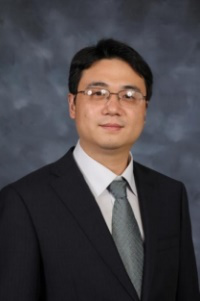报告题目一: 无线通信的发展与空时信号处理技术
报告人:刘琚 山东大学
报告时间:2019年7月11日 9:00-10:00
报告题目二: Unsupervised Bayesian Learning of Breast Cancer Detection with THz Imaging
报告人:Jingxian Wu
Professor, Department of Electrical Engineering, University of Arkansas
报告时间:2019年7月11日 10:00-11:00
报告地点:崂山校区信息学院(D2楼)402报告厅
报告一简介:
本报告将首先介绍无线移动通信系统的需求和技术演进,以及关键技术的发展趋势,然后报告我们在大规模天线、全双工无线通信等方面的研究进展。重点介绍大规模天线(Massive MIMO)干扰处理、全双工(Full-Duplex)通信技术和多蜂窝多用户非正交多址(NOMO)系统上行干扰拟制、功率分配和频谱效率优化方法,最后给出一种最优中继选择的协作NOMA方案。
刘琚教授简历:

刘琚,工学博士,教授、博士生导师。中国电子学会高级会员,IEEE Senior Member。现为山东大学信息科学与工程学院副院长,山东大学研究生教育教学指导委员会副主任;教育部“新世纪优秀人才”,济南市优秀创新团队领军人物,海信数字多媒体技术国家重点实验室特聘教授。
1986年于山东大学无线电系获理学学士学位;1989年于山东大学电子工程系获理学硕士学位并留校任教,2000年于东南大学无线电工程系获工学博士学位。2002年到2003年作为访问教授在西班牙加泰罗尼亚理工大学和通信技术研究中心从事多天线(MIMO)技术研究。2005年11月到2006年1月受DAAD项目资助赴德国不来梅大学和杜伊斯堡-埃森大学合作研究。2018年3月受日本学术振兴会邀请赴日本立命馆大学和山口大学合作研究。2009、2012和2019年受国家留学基金委资助作为高级研究学者分别在美国华盛顿大学、加州大学圣迭戈分校和英国南安普顿大学访问。
主要研究方向:智能通信与多媒体信息处理,盲信号处理理论与应用等。承担了国家重点研发计划、国家自然科学基金和山东省重大专项等多项课题,出版专著2部,省部级科技奖励4项,发表论文200余篇。
报告二简介:
This talk presents an unsupervised Bayesian learning algorithm for cancer detection in Terahertz (THz) imaging of freshly excised murine tumors. Unlike most existing works with deterministic detection methods, we adopt a probabilistic learning approach that can iteratively calculate the probability each pixel in a THz image belonging to different types of tissues, such as cancer, fat, muscle, fibrous tissue, etc. Such a probabilistic approach produces important reliability information about the detection results that are not available in conventional methods. Specifically, under a Bayesian framework, a finite mixture model is used to represent the probability distributions of the intensities of pixels in the THz image, with each component in the mixture model corresponding to one tissue type. The prevalence of a specific type of tissue in a pixel can be represented through the weights of corresponding component to be learned through the data, without the need of labeled training data. Two different mixture models, Gaussian mixture and t-mixture models, are employed in the analysis. The empirical posterior distributions of parameters from both models are estimated by using a Markov chain Monte Carlo (MCMC) technique with Gibbs sampling. The performance of the algorithms is evaluated by comparing the detection results to their corresponding pathology results, and experiment results demonstrate the proposed algorithm can classify different tissue types with high accuracy. Overall, THz imaging shows good qualitative comparison to pathology.
Jingxian Wu教授简历:

Jingxian Wu received the B.S. (EE) degree from the Beijing University of Aeronautics and Astronautics, Beijing, China, in 1998, the M.S. (EE) degree from Tsinghua University, Beijing, China, in 2001, and the Ph.D. (EE) degree from the University of Missouri at Columbia, Missouri, USA, in 2005. He is currently a Professor with the Department of Electrical Engineering, University of Arkansas, Fayetteville. His research interests mainly focus on statistical signal processing, large scale data analytics, biomedical signal processing, and wireless communications. He is appointed as a distinguished lecture by the IEEE Vehicular Technology Society for 2018 and 2019. He served as symposium or track co-chairs for a number of international conferences, such as the 2012 IEEE International Conference on Communications, the 2009, 2015, and 2017 IEEE Global Telecommunications Conference, the 2017 International Conference on Communications in China, and the 2017 Wireless Communication and Signal Processing Conference, etc. He served as an Associate Editor of the IEEE TRANSACTIONS ON VEHICULAR TECHNOLOGY from 2007 to 2011 an Editor of the IEEE TRANSACTIONS ON WIRELESS COMMUNICATIONS from 2011 to 2016, and is now serving as an Associate Editor of the IEEE ACCESS.
